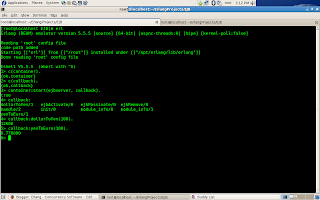What i subsequently did was to combine the both the "GS" and the Sieve of Eratosthenes to produce a graphical version of the "sieving" problem. The point of this exercise was to illustrate how easy it was to code in Erlang once you have gotten used to its semantics, i had fun doing it.
Owing to my laptop's screen resolution, i could only manage a 25-by-25 grid but that's not the point of this exercise. Here are some screen shots and a working code (Code needs to be smoothen though, let me know your comments)
There are three screenshots below of this application to illustrate the program sieving through the numbers
%
% This is an attempt to create a GUI version of the "Sieve of Erasothenes'
%
%
-module(sievegui).
-export([start/0, init/1]).
-copyright('Copyright (c) 2007 Raymond Tay').
-vsn('$Revision: 1').
%
% The following generates a list of multiples-of-Base
% e.g. To generate multiples of 3 less than 100, enter "sieve:genmulti(0,3,100)"
% and you get [9,12,15,18|...]
%
genmulti(Index,Base,Limit) when (Base*Base+Index*Base) > Limit -> [];
genmulti(Index,Base,Limit) when (Base*Base+Index*Base) =< Limit -> [Base*Base+Index*Base | genmulti(Index+1,Base,Limit) ].
sleep(T) ->
receive
after T -> ok
end.
%
% Obtains the GS's "object id" and manipulates the display
%
filterDisplay(ObjId,List) ->
{_,ObjValue} = gs:read(ObjId, label),
{IntValue,X} = string:to_integer(ObjValue),
Result = lists:member(IntValue,List),
if
Result =:= true -> gs:config(ObjId,[{label, {text, ""}}]);
Result =:= false -> ok
end,
sleep(50).
% filterDisplay(ObjId,List) ->
% {_,ObjValue} = gs:read(ObjId, label),
% Result = lists:member(ObjValue,List),
% if
% Result =:= true -> gs:config(ObjId,[{label, {text, ""}}])
% end.
removeMultiples(Index, List, Limit, Dict) when Index /= erlang:length(List) ->
Head = lists:nth(Index,List),
RemoveList = genmulti(0,Head,Limit),
Keys = dict:fetch_keys(Dict),
lists:foreach( fun(X) -> filterDisplay(X,RemoveList) end, Keys),
NewList = List -- RemoveList,
removeMultiples(Index+1, NewList, Limit, Dict);
removeMultiples(Index, List, _, _) when Index =:= erlang:length(List) -> List.
%
% A standard Erlang "for"-loop
%
for(N,N,F) -> F();
for(I,N,F) -> F(),for(I+1,N,F).
forL(N,N,{stretch,_N,_X}) -> [{stretch,_N,_X}];
forL(I,N,{stretch,_N,_X}) -> [{stretch,_N,_X}|forL(I+1,N,{stretch,_N,_X})].
%
% start() -> You can call this if you wish; the only difference between this and init() is that start() starts
% a spawned process
%
start() -> spawn(gsdemo, init, [625]).
%
% Generates the GUI for the button
% where the label for each button is that of incremental number
%
genBut(Row,Col,Text,Dict) when Row*Col =< 625 ->
if
Col =< 25 ->
%io:format("R:~p,C:~p,T:~p~n", [Row,Col,erlang:integer_to_list(Text,10)]),
ButId = gs:button(packer, [{label, {text, erlang:integer_to_list(Text,10)}}, {pack_xy, {Col,Row}}]),
NewDict = dict:store(ButId, ButId, Dict),
NewText = Text+1,
genBut(Row,Col+1, NewText, NewDict);
Col > 25 -> genBut(Row+1, 1, Text, Dict)
end;
genBut(Row,Col,_Text, Dict) when Row*Col > 625 -> Dict.
%
% init() - You can call this if you wish
%
init(Num) ->
_Dict = dict:new(), % process dictionary
WH = [{width, 800}, {height, 800}],
Win = gs:window(gs:start(), [{map, true}, {configure, true}, {title, "Sieve of Erasothenes"} |WH]),
XOpts = forL(1,25,{stretch,1,8}),
YOpts = forL(1,25,{stretch,1,8}),
gs:frame(packer, Win, [{packer_x, XOpts}, {packer_y, YOpts}]),
NewDict = genBut(1,1,2,_Dict),
gs:config(packer, WH), %refresh to initial size
List = lists:seq(2,Num),
FinalList = removeMultiples(1, List, lists:max(List), NewDict),
loop().
%
% A typical loop for receiving messages
%
loop() ->
receive
{gs,_Id,destroy,_Data,_Arg} -> bye;
Other -> loop()
end.



That's it, all comments are welcome.



